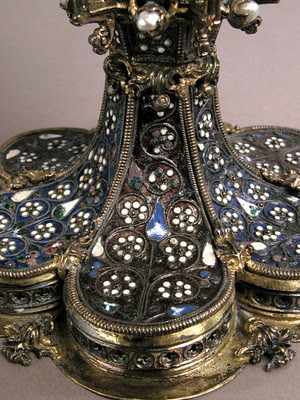My recent visit to the Schnütgen Museum in Cologne got me thinking about museums focusing mainly on medieval art. I decided to make a brief list of such museums, with direct links to their collection databases - thousands of medieval artworks can be discovered this way.
 |
| Reliquary ('Ursulabüste'), Museum Schnütgen, Köln |
Let's start with the Schnütgen Museum, then (Museum Schnütgen, Köln). Located in the Romanesque church of St. Cecilia, this 100 year old museum received a complete makeover, completed last year. The new entrance opens from a large hall, which is in the new building erected for the Rautenstrauch-Joest-Museum, a museum of world cultures. The collection of the Schnütgen Museum consists largely of Christian religious objects, ranging from the Early Christian period to the Baroque, with a strong focus on sculpture, liturgical textiles and stained glass from Cologne and the Rheinland. There is no full collection database online, and the English version of the website only provides basic information. The website however does provide a good overview of chief works on display. An audioguide to the museum is available for download - although I don't know what its purpose is without the artworks.
 |
| Lady with the Unicorn, Musée Cluny, Paris |
Maybe the most famous of all medieval art museums is the Musée Cluny in Paris - officially the Musée national du Moyen Age. Located in the building of the Gallo-Roman thermes and the 15th century Hôtel de Cluny, and surrounded by a medieval garden, visiting this museum is a unique experience. The collection ranges from late Antiquity to the late Middle Ages, and includes exceptional goldsmith works, stone sculptures from Parisian churches - such as the Notre-Dame, as well as the famous Unicorn tapestries. There is a brief overview of the collection on the museum's website, but a lot more objects and images can be found through the photo agency of the Réunion des musées nationaux (where you can search for specific objects, but also by selecting the museum on the search form). The Museum's objects are also incorporated into the French national art database, Joconde. You can select the Musée Cluny directly, or search for thousands of other medieval objects in various French collection. In addition, a fascinating resource on the museum is also available online: the catalogue of 13th century sculptures (Les sculptures du XIIIe siècle du musée de Cluny).
 |
| The Unicorn in Captivity The Cloisters, The Metropolitan Museum |
The only similar museum to the Musée Cluny is on the other side of the Atlantic, in Manhattan: The Cloisters, a branch of the Metropolitan Museum of Art, New York. Housed in a large pseudo-medieval structure, which contains actual chapels and cloisters shipped over from Europe, this is one of the finest collections of medieval art anywhere. The website of the Metropolitan Museum provides a lot of information on The Cloisters, and also on the medieval department, including a selection of works on view. The collection is rich in sculptures of all kind, goldsmith works, manuscripts and also includes another set of Unicorn tapestries. You can search these objects in the museum's Collection Database, which is continually growing. If you select The Cloisters from the list of collections, 2300 objects can be browsed at present (about half of which are on view). Selecting the Collection of Medieval Art from the list yields an incredible further 6700 medieval objects in the database.
You can also download the Metropolitan Museum's Resource for Educators on Medieval Art.
I would like to mention that many other American museums made their collections accessible online. For medieval art, I would particularly recommend the database of the The Walters Art Museum in Baltimore (see also the manuscripts there!) and that of The Cleveland Museum of Art, with 1214 works online.












